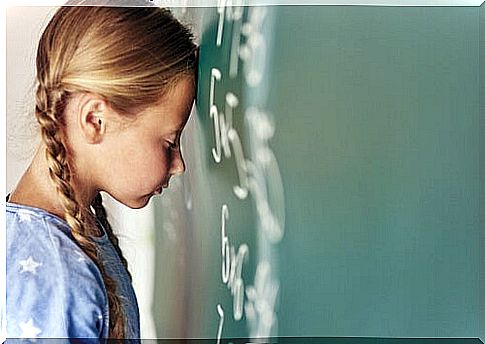Acalculia, The Inability To Understand Numbers

Imagine for a moment that you cannot understand numbers and calculations as simple as 2 or 2 + 2. This alteration of mathematical abilities, known as acalculia, was described by the neurologist Salomon Henschen in 1925 and to this day amazes the world of science.
What if we told you that an area of your brain is responsible for mathematical calculations? It would be something like a built-in calculator, right? In this sense, acalculia is a deficit that directly affects the ability to calculate due to acquired brain damage.
The different types of acalculia
The acalculias are divided into two large groups according to the altered capacities and the damaged areas. In general, the affected hemisphere is the left, in charge of logical reasoning. Likewise, the classification of acalculias will depend on both the area of the left hemisphere affected and the degree to which the abilities are altered.

Primary Acalculia
Primary acalculia is a defect in calculation skills not linked to other disorders. Patients lose the ability to understand number concepts and therefore combine them.
The main flaws are seen in the execution of operations and in more abstract issues, such as the use and interpretation of signs. The lesions are associated with the frontal lobe of the left hemisphere. This lobe is considered the conductor in our brain, so its alteration entails an inability to alternate mathematical concepts. So we can differentiate two clear symptoms of primary acalculia :
- Anarimetic. Impossibility to perform arithmetic calculations.
- Asyntactic. Loss of computational sense.
Secondary Acalculia
Secondary acalculia consists of the alteration of mathematical abilities in association with other neuropsychological disorders. Then secondary acalculia can derive from a linguistic, spatial and executive function deficit in general. In summary, we can group them into the following categories:
- Aphasic Acalculia. The defects in the calculation come from linguistic alterations. The inability to understand and code numerical language leads to an inability to operate with it.
- Allexic Acalculia. Mainly linked to the problems of reading and recognition of number symbols. The patient cannot understand through reading.
- Acalculia agráfica. Agraphy is the inability to communicate and express oneself through writing. This disorder does not come from the inability to execute the movement, but from the misunderstanding of the act of writing on a symbolic level. Consequently, the patient is unable to write numbers.
- Frontal acalculia. Perhaps the most common among acalculias. It is closely linked with attentional disorders. Such patients tend to persevere, which consists of repeating mistakes consistently. This condition is produced by the inability to identify errors and propose new solution strategies.
- Semantic Acalculia. It is a difficulty in handling the concepts of relationship. A clear example would be the inability to associate mathematical problems with the operations necessary for their solution.
- Space Acalculia. It would be the consequence of an injury to the right hemisphere. Difficulty in performing arithmetic calculations is associated with problems in spatial processing.
How is a primary acalculia diagnosed?
The most important thing is to observe that the symptoms are expressed both orally and in writing. Primary acalculia consists of a loss of number concept, which can sometimes be confused with different aphasic symptoms. It is necessary to verify that the deficit is due to the loss of the concept and not to a failure in the verbal understanding of the instructions.
Why do patients with frontal injuries fail in numerical tasks?
First, solving numerical tasks requires a plan in which different mathematical concepts are integrated. To solve a sum, for example, it is necessary to understand the concept of additivity. Second, most mathematical problems require abstract reasoning. The lack of inhibition in syndromes typical of a frontal lesion, hinders this process when concentration fails.
Finally, both selective attention and sequential integration required by numerical operations are affected by poor integration of visual and / or auditory stimuli. As we mentioned earlier, the frontal lobe is the conductor of the brain orchestra; If it presents failures, it will be more difficult to arrange the information in a way that favors the resolution of the problem.

Acalculia and other conditions
Acalculia can be seen in aphasic subjects as long as their linguistic abilities are affected. In Broca’s aphasia, for example, the deficit is manifested in the syntax applied to the calculus. In allexic acalculia, on the other hand, the deficit is correlated with reading difficulties.
A more explanatory example is pure alexia, where the difficulties for the verbal and literal interpretation of the written language are evidenced in the erroneous interpretation of the numbers, magnitudes and hierarchies.
Other ways to detect acalculia
In agraphy, acalculia may appear related to the inability to write quantities. Thus, the type of acalculia will depend on the type of agraphy.
In Wernicke’s aphasia, for example, the patient has errors in copying numbers to dictation. To overcome this deficit in verbal comprehension, these patients usually invent the numbers and assign them their own order.
The acalculia approach
The main thing is to understand that it is a very different disorder from dyscalculia, which consists of a developmental and learning problem, and therefore requires other intervention strategies. For its part, the diagnosis of acalculias is usually in the hands of neuropsychologists, who use various tests. In them, the person has to carry out mental and written arithmetic operations, successive operations, interpretation of arithmetic signs and alignment of numbers in columns.
Treatment of primary acalculia will depend on the type of injury and its severity. Since lost nerve tissue cannot be recovered, rehabilitation often focuses on one goal: teaching new strategies based on neuroplasticity.
Although the recovery will never be complete, tools must be given that improve the adaptation of the person. On the other hand, the treatment of secondary acalculia will vary according to the associated disorder. Advancing technology provides computing tools and applications that are hopeful for patients.









